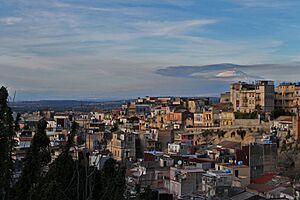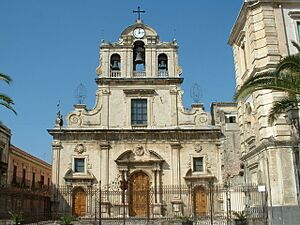Lentini facts for kids
Quick facts for kids
Lentini
Lintini (Sicilian)
|
||
|---|---|---|
| Comune di Lentini | ||
 |
||
|
||
| Country | Italy | |
| Region | Sicily | |
| Province | Syracuse (SR) | |
| Area | ||
| • Total | 215.75 km2 (83.30 sq mi) | |
| Elevation | 53 m (174 ft) | |
| Population
(30 November 2017)
|
||
| • Total | 23,516 | |
| • Density | 108.997/km2 (282.300/sq mi) | |
| Demonym(s) | Lentinese | |
| Time zone | UTC+1 (CET) | |
| • Summer (DST) | UTC+2 (CEST) | |
| Postal code |
96016
|
|
| Dialing code | 095 | |
| Patron saint | St. Alphius | |
| Saint day | May 10 | |
Lentini is a town in southeastern Sicily, Italy. It's located about 35 kilometers (22 miles) northwest of Syracuse. The town is known by different names in history, like Lintini in Sicilian and Leontīnī in Latin.
Contents
History of Lentini
Founding and Early Years
Lentini was first settled by people from Naxos in 729 BC. It was called Leontini back then. Naxos was a Chalcidian colony, which means it was a settlement started by people from the ancient Greek city of Chalcis. Lentini is special because it's one of the few Greek settlements in Sicily not built right on the coast. It was founded about 10 kilometers (6 miles) inland. The Greeks took over this area from the Sicels, who were the original inhabitants, because the land was very fertile.
Changes in Power
Over time, Lentini faced many changes in who ruled it. In 494 BC, a ruler named Hippocrates of Gela made Lentini a subject city. Later, in 476 BC, Hieron of Syracuse moved people from other cities like Catana and Naxos to Lentini.
Lentini managed to gain its independence again. To keep their freedom, the people of Lentini often asked Athens, a powerful Greek city-state, for help. A famous speaker named Gorgias from Lentini convinced Athens to send an expedition in 427 BC, but it didn't succeed.
In 422 BC, the city of Syracuse supported the rich and powerful people (called oligarchs) in Lentini against the common people. This led to Lentini being abandoned for a while. This situation made Athens get involved again. The people who were forced to leave Lentini joined others in convincing Athens to launch a big military mission called the Sicilian Expedition in 415 BC.
Later History and Disasters
After the Athenian expedition failed, Lentini came under the control of Syracuse once more. A treaty in 405 BC between Dionysius and the Carthaginians was supposed to guarantee Lentini's independence, but it didn't last long. The city was eventually attacked and captured by Marcus Claudius Marcellus in 214 BC.
During Roman times, Lentini was not a very important city. It was destroyed by the Saracens in 847 AD. Then, in 1693, a massive earthquake almost completely ruined the town.
Ancient City Layout
An ancient historian named Polybius described the old city of Lentini. He said it was in a valley between two hills and faced north. A river flowed on the western side of this valley, with houses along its bank. There was a gate at each end of the valley: one leading to a plain in the north and another leading to Syracuse in the south. On each side of the valley, there was a high, fortified area called an acropolis. Today, on the eastern hill, you can still see the remains of a strong medieval castle.
Main Sights in Lentini
Lentini has several interesting places to visit:
- Santa Maria la Cava e Sant'Alfio (Mother Church of St Mary of the Cave and St Alphius): This beautiful Baroque church was built after the 1693 earthquake. It has three main sections inside. The front of the church, built in the 1700s, shows scenes of the martyrdom (suffering) of Saints Alphius, Philadelphus and Cyrinus. Inside, there's a very old Byzantine icon from the 1100s.
- Santissima Trinità e San Marziano (Holy Trinity and St Marcian): This church was built on the remains of an old palace. It has a beautiful floor made of ceramic tiles from Caltagirone (from the 1700s). You can also see a special artwork called a polyptych, which is a painting with many panels, from the school of Antonello da Messina. The altar has a tabernacle made of lapis lazuli, a beautiful blue stone.
- Chiesa dell'Immacolata (Church of Mary of the Immaculate Conception): This church from the 1600s has an old Romanesque lion sculpture. It also features a sculpture of Christ at the Column and the tombstone of Queen Mary from 1402.
- San Luca (St Luke): This church has a painting of St Francis of Assisi that might be from the school of Bassano, a famous painter. Next to the church, you can find the remains of a castle built by Frederick II. There's also the hypogeum (an underground tomb or cave) of St. Lucy with frescoes (wall paintings) from the 1300s. The Crucifix Grottoes also have frescoes from the 1100s to the 1600s. You can also see the ruins of the old San Pietro church from the 1500s.
- San Francesco di Paola: This 18th-century church has a rare organ and artworks saved from other churches destroyed by the 1693 earthquake.
- Lago di Lentini or Biviere: This lake is not far from the city. It was once drained but was rebuilt in the 1970s in its original spot. The lake is now full of plants and animals, making it a rich natural area.
Economy of Lentini
Lentini's economy mostly depends on agriculture. People also work in woodcraft and make handmade goods. The city is especially famous for growing blood oranges. These are special types of oranges with red flesh, including varieties like tarocco, moro, and sanguinella.
Climate in Lentini
Lentini has a Mediterranean climate. This means it has mild winters and hot summers. In the coldest months, the average daytime temperature is around 15°C (59°F). In the warmest months, the average daytime temperature reaches about 34°C (93°F). In summer, temperatures often go above 40°C (104°F) and can even reach over 45°C (113°F) sometimes. Even in winter, temperatures can go above 15°C (59°F) yearly, and sometimes even over 20°C (68°F). Winter nights can sometimes drop to 0°C (32°F), but rarely go below freezing. Summer nights usually stay above 17°C (63°F), but can occasionally drop to 15°C (59°F). While it's generally dry all year, it rains much less in summer than in winter.
People from Lentini
- Gorgias (around 485 – 380 BC): A very important ancient Greek philosopher and speaker.
- Giacomo da Lentini: A poet from the 1200s who is believed to have invented the sonnet, a type of poem.
- Filadelfo Mugnos (1607–1675): A writer and historian who wrote about the noble families of Sicily.
- Jeffrey Jey (born 1970): A singer and the lead vocalist for the popular music group Eiffel 65.
- Giuseppe Malpasso (born 1970): A filmmaker.
See also
- Sicula Leonzio, a football club from Lentini
- Blood orange, a special fruit grown in Lentini
- Sicily, the region where Lentini is located


